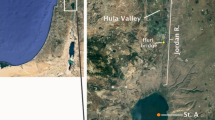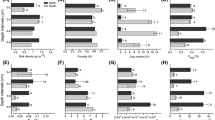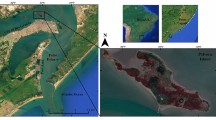Abstract
The levels and speciation of dissolved, particulate and gaseous Se have been measured in five thermokarst ponds in a sporadic and discontinuous permafrost region of northern Québec (Canada) during summer oxygen stratification. Evolution of Se concentrations with depth was investigated in sediment cores collected in three different ponds. The potential for inorganic Se transformation in natural pond waters was investigated by experimental incubations of isotopic species-specific tracers of selenite and selenate. Experimental and monitoring observation revealed that high dissolved carbon concentration, suspended particle matter concentration, heterotrophic activity and periphytic biofilms have a significant role in the formation of gaseous selenium species. In sediment, Se is mainly associated with organic matter in the concentration range 0.14–1.6 mg kg−1. Despite low outgassing rates of volatile Se toward the atmosphere (1–97 ng Se m−2 day−1), the large surface occupied by ponds in northern Canada may lead to important exchange rates (ca. 1 ton year−1) at the global scale. Detailed measurements of Se speciation, including volatile compounds, and its reactivity toward heterotrophic activity in selected thaw ponds from the Canadian Subarctic provides new insight to better constrain the biogeochemical pathways leading to Se removal from the water column via atmospheric gas exchange and sediment accumulation.
Similar content being viewed by others
References
ACIA (2004) Impacts of a warming Arctic: Arctic climate impact assessment, overview report. Cambridge University Press, Cambridge
Alanoca L, Amouroux D, Monperrus M, Tessier E, Goni M, Guyoneaud R, Acha D, Gassie C, Audry S, Garcia ME, Quintanilla J, Point D (2016) Diurnal variability and biogeochemical reactivity of mercury species in an extreme high altitude lake ecosystem of the Bolivian Altiplano. Environ Sci Pollut Res 23:6919–6933
Allard M, Seguin MK (1987) The Holocene evolution of permafrost near the tree line, on the eastern coast of Hudson Bay (northern Quebec). Can J Earth Sci 24:2206–2222
Amouroux D, Donard OFX (1996) Maritime emission of selenium to the atmosphere in Eastern Mediterranean seas. Geophys Res Lett 23(14):1777–1780
Amouroux D, Donard OFX (1997) Evasion of selenium to the atmosphere via biomethylation processes in the Gironde estuary, France. Mar Chem 58:173–188
Amouroux D, Tessier E, Pécheyran C, Donard OFX (1998) Sampling and probing volatile metal(loid) species in natural waters by in situ purge and cryogenic trapping followed by gas chromatography and inductively coupled plasma mass spectrometry (P-CT-GC-ICP/MS). Anal Chim Acta 377:241–254
Amouroux D, Pécheyran C, Donard OFX (2000) Formation of volatile selenium species in synthetic seawater under light and dark experimental conditions. Appl Organomet Chem 14:236–244
Amouroux D, Liss PS, Tessier E, Hamren-Larsson M, Donard OFX (2001) Role of oceans as biogenic sources of selenium. Earth Planet Sci Lett 189:277–283
Balistrieri LS, Chao TT (1990) Adsorption of selenium by amorphous iron oxyhydroxide and manganese dioxide. Geochim Cosmochim Acta 54:739–751
Beavington F, Cawse PA, Wakenshaw A (2004) Comparative studies of atmospheric trace elements: improvements in air quality near a copper smelter. Sci Total Environ 332:39–49
Belzile N, Chen YW, Xu R (2000) Early diagenetic behavior of selenium in freshwater sediments. Appl Geochem 15:1439–1454
Bennett JP (1995) Abnormal chemical element concentrations in lichens of Isle Royale National Park. Environ Exp Bot 35:259–277
Besser JM, Huckins JN, Little EE, La Point TW (1989) Distribution and bioaccumulation of selenium in aquatic microcosms. Environ Pollut 62:1–12
Besser JM, Canfield TJ, Lapoint TW (1993) Bioaccumulation of organic and inorganic selenium in a laboratory food-chain. Environ Toxicol Chem 12:57–72
Bhiry N, Delwaide A, Allard M, Bégin Y, Filion L, Lavoie M, Nozais C, Payette S, Pienitz R, Saulnier-Talbot É, Vincent WF (2011) Environmental change in the Great Whale River region, Hudson Bay: five decades of multidisciplinary research by centre d’études Nordiques (CEN). Ecoscience 18:182–203
Blazina T, Läderach A, Jones GD, Sodemann H, Wernli H, Kirchner JW, Winkel LHE (2017) Environ Sci Technol 51:108–118
Borges AV, Delille B, Schiettecatte LS, Gazeau F, Abril G, Frankignoulle M (2004) Gas transfer velocities of CO2 in three European estuaries (Randers Fjord, Scheldt, and Thames). Limnol Oceanogr 49:1630–1641
Bouchard F, Francus P, Pienitz R, Laurion I (2011) Sedimentology and geochemistry of thermokarst ponds in discontinuous permafrost, subarctic Quebec, Canada. J Geophys Res 116:G00M04
Bouchard F, Francus P, Pienitz R, Laurion I, Feyte S (2014) Subarctic thermokarst ponds: investigating recent landscape evolution and sediment dynamics in thawed permafrost of northern Québec (Canada). Arct Antarct Alp Res 46:251–271
Bouchet S, Tessier E, Monperrus M, Bridou R, Clavier J, Thouzeau G, Amouroux D (2011) Measurements of gaseous mercury exchanges at the sediment–water, water–atmosphere and sediment–atmosphere interfaces of a tidal environment (Arcachon Bay, France). J Environ Monit 13:1351–1359
Brown J, Ferrians OJ, Heginbottom JA, Melnikov ES (1998) Digital CircumArctic Map of Permafrost and Ground-Ice Conditions. In: International Permafrost Association, Data and Information Working Group, comp. Circumpolar Active Layer Permafrost System (CAPS), version 1.0. CD-ROM available from National Snow and Ice Data Center, nsidc@kryos.colorado.edu. NSIDC, University of Colorado, Boulder
Bryan GW, Langston WJ (1992) Bioavailability, accumulation and effects of heavy metals in sediments with special reference to the United Kingdom estuaries: a review. Environ Pollut 76:89–131
Calmels F, Allard M, Delisle G (2008) Development and decay of a lithalsa in Northern Québec: a geomorphological history. Geomorphology 97:287–299
Carignan J, Gariépy C (1995) Isotopic composition of epiphytic lichens as a tracer of the sources of atmospheric lead emissions in southern Québec, Canada. Geochim Cosmochim Acta 59:4427–4433
Clark JF, Schlosser P, Simpson HJ, Stute M, Wanninkhof R, Ho DT (1995) Relationship between gas transfer velocities and wind speeds in the tidal Hudson River determined by the dual tracer technique. In: Jähne B, Monahan EC (eds) Air-Water Gas Transfer. Hanau, Germany
Cofala J, Amann M, Klimont Z, Kupiainen K, Höglund-Isaksson L (2007) Scenarios of global anthropogenic emissions of air pollutants and methane until 2030. Atmos Environ 41:8486–8499
Cole JJ, Caraco NF (1998) Atmospheric exchange of carbon dioxide in a low-wind oligotrophic lake measured by the addition of SF6. Limnol Oceanogr 43:647–656
Comte J, Monier A, Crevecoeur S, Lovejoy C, Vincent WF (2015) Microbial biogeography of permafrost thaw ponds across the changing northern landscape. Ecography 38:001–010
Cooke TD, Bruland KW (1987) Aquatic chemistry of selenium: evidence of biomethylation. Environ Sci Technol 21:1214–1219
Coppin F, Chabroullet C, Martin-Garin A, Balesdent J, Gaudet JP (2006) Methodological approach to assess the effect of soil ageing on selenium behaviour: first results concerning mobility and solid fractionation of selenium. Biol Fertil Soils 42:379–386
Coulombe O, Bouchard F, Pienitz R (2016) Coupling of sedimentological and limnological dynamics in subarctic thermokarst ponds in Northern Québec (Canada) on an interannual basis. Sediment Geol 340:15–24
Crevecoeur S, Vincent WF, Comte J, Lovejoy C (2015) Bacterial community structure across environmental gradients in permafrost thaw ponds: methanotroph-rich ecosystems. Front Microbiol 6:192
Cutter GA, Church TM (1986) Selenium in western Atlantic precipitation. Nature 322:720–722
Cutter GA, Cutter LS (2004) Selenium biogeochemistry in the San Francisco Bay estuary: changes in water column behavior. Estuar Coast Shelf S 61:463–476
Dauthieu M, Bueno M, Darrouzes J, Gilon N, Potin-Gautier M (2006) Evaluation of porous graphitic carbon stationary phase for simultaneous preconcentration and separation of organic and inorganic selenium species in “clean” water systems. J Chromatogr A 1114:34–39
de Souza MP, Huang CPA, Chee N, Terry N (1999) Rhizosphere bacteria enhance the accumulation of selenium and mercury in wetland plants. Planta 209:259–263
Deshpande BN, Crevecoeur S, Matveev A, Vincent WF (2016) Bacterial production in subarctic peatland lakes enriched by thawing permafrost. Biogeosciences 13:4411–4427
Dhillon KS, Dhillon SK (2003) Distribution and management of seleniferous soils. Adv Agron 79:119–184
Dunn CE (1990) Lithogeochemical study of the Cretaceous in Central Saskatchewan—preliminary report. Miscellaneous report 90-4. Saskatchewan Geological Survey, Saskatchewan Energy and Mines
Diaz X, Johnson WP, Oliver WA, Naftz DL (2009) Volatile selenium flux from the great salt lake. Utah. Environ Sci Tech 43(1):53–59
Ellwood MJ, Schneider L, Potts J, Batley GE, Floyd J, Maher WA (2015) Volatile selenium fluxes from selenium-contaminated sediments in an Australian coastal lake. Environ Chem 13:68–75
Garbisua C, Ishii T, Leighton T, Buchanan BB (1996) Bacterial reduction of selenite to elemental selenium. Chem Geol 132:199–204
Garrett RG, Thorleifson LH, Matile G, Adcock SW (2008) Till geochemistry, mineralogy and lithology, and soil geochemistry—data from the 1991–1992 Prairie Kimberlite Study. Geological Survey of Canada Open File 5582
Gustafsson JP, Johnsson L (1994) The association between selenium and humic substances in forested ecosystems-laboratory evidence. Appl Organomet Chem 8:141–147
Hillaire-Marcel C (1976) La déglaciation et le relèvement isostatique sur la côte est de la baie d’Hudson. Cahiers de géographie du Québec 20:185–220
Hinojosa Reyes L, Marchante-Gayón JM, García Alonso JI, Sanz-Medel A (2003) Determination of selenium in biological materials by isotope dilution analysis with an octopole reaction system ICP-MS. J Anal Atom Spectrom 18:11–16
Johnson CC, Ge X, Green KA, Liu X (2000) Selenium distribution in the local environment of selected villages of the Keshan Disease belt, Zhangjiakou District, Hebei Province, People’s Republic of China. Appl Geochem 15:385–401
Kagawa M, Ishizaka Y, Ohta K (2003) Sources of sulfate in winter aerosols over the Sea of Japan, as inferred from selenium composition. Atmos Environ 37:1593–1600
Lag J, Steinnes E (1974) Soil selenium in relation to precipitation. Ambio 3:237–238
Laurion I, Vincent WF, MacIntyre S, Retamal L, Dupont C, Francus P, Pienitz R (2010) Variability in greenhouse gas emissions from permafrost thaw ponds. Limnol Oceanogr 55:115–133
LeBlanc KL, Wallschläger D (2016) Production and release of selenomethionine and related organic selenium species by microorganisms in natural and industrial waters. Environ Sci Technol 50:6164–6171
Lemly AD (1994) Mining in northern Canada: expanding the industry while protecting arctic fishes—a review. Ecotoxicol Environ Saf 29:229–242
Lemly AD (2004) Aquatic selenium pollution is a global environmental safety issue. Ecotoxicol Environ Saf 59:44–56
Liss PS, Merlivat L (1986) In: Buat-Ménard P. (eds) The role of air-sea exchange in geochemical cycling. NATO ASI Series (Series C: Mathematical and Physical Sciences), vol 185. Springer, Dordrecht
Liss PS, Slater PG (1974) Flux of Gases across the Air-Sea Interface. Nature 247:181–184
Luoma S, Rainbow PS (eds) (2008) Metal contamination in aquatic environments: science and lateral management. Cambridge University Press, Cambridge
Luxem KE, Vriens B, Behra R, Winkel LHE (2017) Studying selenium and sulfur volatilisation by marine algae Emiliania huxleyi and Thalassiosira oceanica in culture. Environl Chem 14:199–206
Maenhaut W, Cornille P, Pacyna JM, Vitols V (1989) Trace element composition and origin of the atmospheric aerosol in the Norwegian arctic. Atmos Environ 23:2551–2569
Mason RP, Soerensen AL, DiMento BP, Balcom PH (2018) The global marine selenium cycle: insights from measurements and modeling. Global Biogeochem Cy 32:1720–1737
Masscheleyn PH, Patrick WH Jr (1993) Biogeochemical processes affecting selenium cycling in wetlands. Environ Toxicol Chem 12:2235–2243
Masscheleyn PH, Delaune RD, Patrick WH Jr (1990) Transformations of selenium as affected by sediment oxidation-reduction potential and pH. Environ Sci Technol 24:91–96
Mosher BW, Duce RA (1987) A global atmospheric selenium budget. J Geophys Res 92:13289–13298
Myneni SCB, Tokunaga TK, Brown GE (1997) Abiotic Selenium redox transformations in the presence of Fe (II, III) oxides. Science 278:1106–1109
Nriagu JO (1989) A global assessment of natural sources of atmospheric trace metals. Nature 338:47–49
Nriagu JO, Davidson CI (1986) Toxic metals in the atmosphere. Wiley, New York
Nriagu JO, Pacina JM (1988) Quantitative assessment of worldwide contamination of air, water and soils by trace metals. Nature 333:134–139
Oremland RS, Hollibaugh JT, Maest AS, Presser TS, Miller LG, Culbertson CW (1989) Selenate reduction to elemental selenium by anaerobic bacteria in sediments and culture: biogeochemical significance of a novel, sulfate-independent respiration. Appl Environ Microbiol 55:2333–2343
Oremland RS, Herbel MJ, Switzer Blum J, Langley S, Beveridge TJ, Ajayan PM, Sutto T, Ellis AV, Curran S (2004) Structural and spectral features of selenium nanospheres produced by Se-respiring bacteria. Appl Environ Microbiol 70:52–60
Pacyna JM, Pacyna EG (2001) An assessment of global and regional emissions of trace metals to the atmosphere from antropogenic sources worldwide. Environ Rev 9:1–30
Payette S, Bouchard A (2001) Le contexte physique et biogéographique. In: Payette S, Rochefort L (eds) Écologie des tourbières du Québec-Labrador. Les Presses de l’Université Laval, Québec
Payette S, Rochefort L (eds) (2001) Écologie des Tourbières du Québec-Labrador. Presse de l’Université Laval, Québec
Payette S, Delwaide A, Caccianiga M, Beauchemin M (2004) Accelerated thawing of subarctic peatland permafrost over the last 50 years. Geophys Res Lett 31:L18208
Pienitz R, Doran P, Lamoureux S (2008) Origin and geomorphology of lakes in the polar regions. In: Vincent WF, Laybourn-Parry J (eds) Polar Lakes and Rivers-Limnology of Arctic and Antarctic Aquatic Ecosystems. Oxford University Press, Oxford
Pokrovsky OS, Bueno M, Manasypov RM, Shirokova LS, Karlsson J, Amouroux D (2018) Dissolved organic matter controls seasonal and spatial selenium concentration variability in thaw lakes across a permafrost gradient. Environ Sci Technol 52:10254–10262
Presser TS, Luoma SN (2010) A methodology for ecosystem-scale modeling of selenium. Integr Environ Asses 6:685–710
Rémy PP (2015) Role of different microbial compartments (biofilms, suspended matters, surface sediment) and some of them components (bacterial cells, extracellular polymeric substances and biominerals) on HgII methylation and reduction. PhD thesis
Riordan B, Verbyla D, McGuire AD (2006) Shrinking ponds in subarctic Alaska based on 1950–2002 remotely sensed images. J Geophys Res 111:G04002
Ross HB (1985) An atmospheric selenium budget for the region 30°N to 90°N. Tellus 37B:78–90
Rossi PG, Laurion I, Lovejoy C (2013) Distribution and identity of Bacteria in subarctic permafrost thaw ponds. Aquat Microb Ecol 69:231–245
Saulnier-Talbot E, Pienitz R (2001) Postglacial isolation of a coastal basin near Kuujjuaraapik-Whapmagoostui, Hudsonie: a diatom biostratigraphical investigation. Geogr Phys Quatern 55:63–74
Séby F, Potin-Gautier M, Lespés G, Astruc M (1997) Selenium speciation in soils after alkaline extraction. Sci Total Environ 207:81–90
Sharmasarkar S, Vance GF (1997) Extraction and distribution of soil organic and inorganic selenium in coal mine environments of Wyoming, USA. Environ Geol 29:17–22
Stolz JE, Basu P, Santini JM, Oremland RS (2006) Arsenic and selenium in microbial metabolism. Annu Rev Microbiol 60:107–130
Telmer K, Bonham-Carter GF, Kliza DA, Hall GEM (2004) The atmospheric transport and deposition of smelter emissions: evidence from the multi-element geochemistry of snow, Quebec, Canada. Geochim Cosmochim Ac 68:2961–2980
Tessier E, Amouroux D, Abril G, Lemaire E, Donard OFX (2002) Formation and volatilisation of alkyl-iodidesand -selenides in macrotidal estuaries. Biogeochemistry 59:183–206
Tietjen T, Vähätalo AV, Wetzel RG (2005) Effects of clay mineral turbidity on dissolved organic carbon and bacterial production. Aquat Sci 67:51–60
Tolu J, Le Hécho I, Bueno M, Thiry Y, Potin-Gautier M (2011) Selenium speciation analysis at trace level in soils. Anal Chim Acta 684:126–133
Tolu J, Di Tullo P, Le Hecho I, Thiry Y, Pannier F, Potin-Gautier M, Bueno M (2014) A new methodology involving stable isotope tracer to compare simultaneously short- and long-term selenium mobility in soils. Anal Bioanal Chem 406:1221–1231
Turner A, Turner D, Braungardt C (2013) Biomonitoring of thallium availability in two estuaries of southwest England. Mar Pollut Bull 69:172–177
USEPA (2002) National recommended water quality criteria: 2002. EPA-822 R-02-047. Office of Water, Washington, DC
Vallee S, Payette S (2007) Collapse of permafrost mounds along a subarctic river over the last 100 years (northern Quebec). Geomorphology 90:162–170
Van Dael P, Lewis J, Barclay D (2004) Stable isotope-enriched selenite and selenate tracers for human metabolic studies: a fast and accurate method for their preparation from elemental selenium and their identification and quantification using hydride generation atomic absorption spectrometry. J Trace Elem Med Biol 18:75–80
Velinsky J, Cutter GA (1991) Geochemistry of selenium in a coastal salt marsh. Geochim Cosmochim Acta 55:179–191
Vriens B, Ammann AA, Hagendorfer H, Lenz M, Berg M, Winkel LHE (2014) Quantification of methylated selenium, sulfur, and arsenic in the environment. PLoS ONE 9:e102906. https://doi.org/10.1371/journal.pone.0102906
Vriens B, Behra R, Voegelin A, Zupanic A, Winkel LHE (2016) Selenium Uptake and Methylation by the Microalga Chlamydomonas reinhardtii. Environ Sci Technol 50:711–720
Watanabe S, Laurion I, Chokmani K, Pienitz R, Vincent WF (2011) Optical diversity of thaw ponds in discontinuous permafrost: a model system for water color analysis. J Geophys Res 116:G02003
Wen H, Carignan J (2007) Reviews on atmospheric selenium: emissions, speciation and fate. Atmos Environ 41:7151–7165
Wen H, Carignan J (2009) Ocean to continent transfer of atmospheric Se as revealed by epiphytic lichens. Environ Pollut 157:2790–2797
Winkel LHE, Johnson CA, Lenz M, Grundl T, Leupin OX, Amini M, Charlet L (2012) Environmental selenium research: from microscopic processes to global understanding. Environ Sci Technol 46:571–579
Yamada H, Hattori T (1990) Determination of soluble selenium in soils. Soil Sci Plant Nutr 36:163–166
Zhang Y, Moore JN (1997) Environmental conditions controlling selenium volatilization from a wetland system. Environ Sci Technol 31:511–517
Zhang T, Barry RG, Knowles K, Heginbottom JA, Brown J (2008) Statistics and characteristics of permafrost and ground-ice distribution in the Northern Hemisphere. Polar Geogr 31:47–68
Acknowledgements
We thank Claude Tremblay, Najat Bhiry and Warwick F. Vincent for their support at the field station of Centre for Northern Studies (CEN); Michel Cremer for particle-size distribution analyses; Laura Forsström for support in physico-chemical measures; the TAKUVIK research program and the Arctic Metals project (ANR-11-CESA-0011) for logistic and financial support; posthumously, Jean Carignan, at the origin of the project Arctic Metals.
Author information
Authors and Affiliations
Corresponding author
Additional information
Responsible Editor: R. Kelman Wieder.
Publisher's Note
Springer Nature remains neutral with regard to jurisdictional claims in published maps and institutional affiliations.
Rights and permissions
About this article
Cite this article
Lanceleur, L., Tessier, E., Bueno, M. et al. Cycling and atmospheric exchanges of selenium in Canadian subarctic thermokarst ponds. Biogeochemistry 145, 193–211 (2019). https://doi.org/10.1007/s10533-019-00599-w
Received:
Accepted:
Published:
Issue Date:
DOI: https://doi.org/10.1007/s10533-019-00599-w







